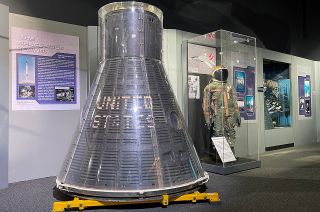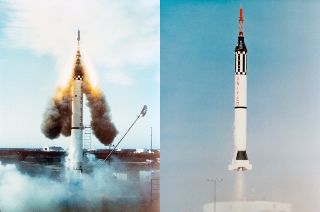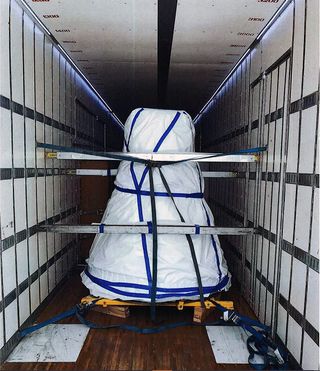1st NASA capsule to fly into space lands at Long Island museum
Mercury capsule completes space race trifecta at Cradle of Aviation.

An early American spacecraft that survived two launches — albeit, the first one only reaching inches above the ground — has touched down at a museum in Long Island, New York.
The United States' first production spacecraft to be launched into space, Mercury-Redstone 1A (MR-1A), is now on exhibit at the Cradle of Aviation in Garden City. The capsule is on long-term loan from the Smithsonian.
"Even though it flew without a person on board, it is historic in that it was the first," Josh Stoff, curator at the Cradle of Aviation Museum, said in an interview with collectSPACE.com. "They were testing the whole parachute system and retro rockets. And it all worked. That led the way to beginning of the space race [to put a human into space], Alan Shepard, John Glenn and all that great stuff."
Built by McDonell Aircraft (today part of Boeing), the MR-1A capsule was shipped to Cape Canaveral, Florida on July 23, 1960, for what was planned as the first launch of a Mercury spacecraft atop a Redstone rocket. Four months later on Nov. 21, the countdown reached zero at 9:00 a.m. EST (1400 GMT), but, instead of climbing to space, the booster's engine shut down and the vehicle settled back on the launchpad, having only traveled about 4 inches (10 centimeters).
Reacting to the off-nominal situation (the result of two cables separating in the wrong order), the Mercury capsule jettisoned its escape rocket and deployed its drogue, main and reserve parachutes.
"There's great footage of that failed launch," said Stoff. "It popped its top."
Project Mercury: America's 1st crewed space program
Get the Space.com Newsletter
Breaking space news, the latest updates on rocket launches, skywatching events and more!

A month later, NASA was prepared to try again. Using the same but refurbished spacecraft and a new rocket, Mercury-Redstone-1A lifted off on Dec. 19, 1960, from Launch Complex 5 (LC-5), this time to a much better outcome. Reaching an altitude of 130 miles (210 kilometers), the MR-1A capsule completed a suborbital spaceflight, qualifying the spacecraft for use in primate and later human missions.
In flight for 15 minutes and 45 seconds, the MR-1A spacecraft splashed down in the Atlantic Ocean, where it was retrieved by helicopters.
"To the average person, it looks identical to what Alan Shepard flew," Stoff said, referring to the capsule's exterior, including its small porthole window. "It has all the structure in there, but you can see they pulled out all the instrumentation. The structure looks complete for the seat and the instrument panel and parachutes, but there's no hardware."
After undergoing post-flight testing, the MR-1A capsule (also known by its production serial number, spacecraft no. 2) went on tour, including stops in 1963 at (the now former) Richards-Gebaur Air Force Base in Kansas City, Missouri; the Kalamazoo Air Show in Michigan; the National Aero Scout Conference at the University of Illinois in Champaign; and the Four State Fair and Rodeo in Texarkana, Texas. In October 1963, it was prepared for an exhibit in New Mexico.
Some time later, the capsule was shipped to Kennedy Space Center in Florida, where it went on display in the visitor information center and then visitor complex positioned under a parachute in the Early Space Exploration Hall.
In 2003, NASA transferred ownership of the spacecraft to the Smithsonian, which then moved MR-1A to NASA's Ames Research Center at Moffett Field in California. It was from there that it came to the Cradle of Aviation.
"It went to Ames and it was just kind of sitting there in a corner of the visitor center. There was really no exhibit around it," Stoff told collectSPACE. "So I think it's getting a better exhibit here, with the whole space race behind told around it."

In addition to displaying the history of the Apollo lunar module, which was built in nearby Bethpage, the Cradle of Aviation also exhibits a vintage full-scale model of a Gemini spacecraft and an Apollo command module (CM 002), which was used in a launch escape system test in 1966.
"So we have now have examples of Mercury, Gemini and both Apollo spacecraft. It's kind of unique to have the whole chronology set up," said Stoff.
The MR-1A capsule was transported by truck from California on a three-day cross-country trip. It arrived at the Cradle of Aviation with its plexiglass shell and custom wheeled dolly already in place. The spacecraft debuted on display late last week, just a month after another new addition, a statue of Sally Ride, the first American woman in space.
"The Mercury spacecraft completes our space race collection and gives us a chance to show an actual flown spacecraft. Very few museums in the country or in the world have flown spacecraft, whether there were astronauts aboard it or not, so it kind of puts us into a next level," Stoff said.
Follow collectSPACE.com on Facebook and on Twitter at @collectSPACE. Copyright 2022 collectSPACE.com. All rights reserved.
Join our Space Forums to keep talking space on the latest missions, night sky and more! And if you have a news tip, correction or comment, let us know at: community@space.com.

Robert Pearlman is a space historian, journalist and the founder and editor of collectSPACE.com, an online publication and community devoted to space history with a particular focus on how and where space exploration intersects with pop culture. Pearlman is also a contributing writer for Space.com and co-author of "Space Stations: The Art, Science, and Reality of Working in Space” published by Smithsonian Books in 2018. He previously developed online content for the National Space Society and Apollo 11 moonwalker Buzz Aldrin, helped establish the space tourism company Space Adventures and currently serves on the History Committee of the American Astronautical Society, the advisory committee for The Mars Generation and leadership board of For All Moonkind. In 2009, he was inducted into the U.S. Space Camp Hall of Fame in Huntsville, Alabama. In 2021, he was honored by the American Astronautical Society with the Ordway Award for Sustained Excellence in Spaceflight History.

